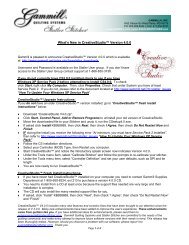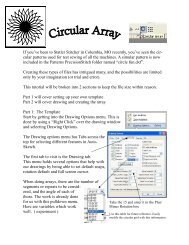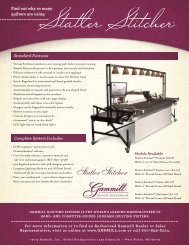You also want an ePaper? Increase the reach of your titles
YUMPU automatically turns print PDFs into web optimized ePapers that Google loves.
84<br />
Getting Started with CreativeStudio<br />
4 Quilting the Quilt - Which CS Feature To use<br />
The quilting process generally includes four phases and uses a variety of<br />
techniques.<br />
1. Baste the quilt layers to stabilize them.<br />
2. Stitch the blocks (or whatever is chosen for the center).<br />
3. Stitch the borders, corners and sashings.<br />
4. Finish by doing any background filler stitching.<br />
The sequence is suggested because it minimizes the risk of distorting the fabric and<br />
getting pleats or tucks. Not all quilts need all phases and the phases aren’t always<br />
done in this sequence – each quilt is unique.<br />
Each CS feature is described in detail in one of these four phases.<br />
4.1 Phase 1 - Basting<br />
Basting is a fundamental process that is used during the initial loading of a quilt and<br />
throughout the quilting process as the quilt is stitched and rolled. There are several<br />
methods for basting. Each method is useful under different circumstances.<br />
Simple quilts may only need to have the three layers secured together and basting is<br />
adequate. Complex quilts may need to have many areas of the quilt stitched<br />
together to prevent the fabrics (especially the backing) from shifting and pulling.<br />
Taking the time to stabilize the quilt will result in a flatter, straighter quilt. Stitch in the<br />
ditch (SID) is commonly used in complex quilts because it secures the fabrics, and<br />
can disappear into the seams.<br />
4.1.1 Securing the Quilt using Baste<br />
Securing the quilt is generally hand-guided, done in regulated mode after the belts<br />
have been disengaged (regulated mode is explained in the next section). For quilts<br />
that only need to be secured on the outer edges, basting is adequate.<br />
Feature: Baste Stitch<br />
The basting stitch is a long stitch and is often temporary. It is commonly used around<br />
the outer edges of a quilt. It might be viewed as being a series of single stitches<br />
rather than continuous stitches. The difference is the amount of pressure the<br />
hopping foot exerts on the fabric. The benefit is that less fabric gets 'pushed' forward<br />
in the direction of the sewing. This is very valuable when trying to prevent stretching<br />
and/or ease in extra fullness.<br />
Assumptions: The quilt is loaded, bobbin is full, machine is threaded and the<br />
belts are (probably) detached. Free motion quilting is usually done without the belts





